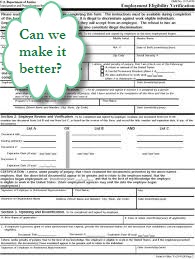 The United States Citizenship and Immigration Services (USCIS) recently published an Executive Summary of a listening session it hosted on November 2, 2010 regarding the Form I-9. The summary, which you can read in full here, attempts to capture stakeholders’ comments and concerns for how to improve the form itself and the overall I-9 process. There were many worthwhile suggestions that we hope USCIS will consider. The following is a list of the more interesting ideas with our comments.
The United States Citizenship and Immigration Services (USCIS) recently published an Executive Summary of a listening session it hosted on November 2, 2010 regarding the Form I-9. The summary, which you can read in full here, attempts to capture stakeholders’ comments and concerns for how to improve the form itself and the overall I-9 process. There were many worthwhile suggestions that we hope USCIS will consider. The following is a list of the more interesting ideas with our comments.
Section 1: Employee Information and Verification
- Make it clearer that providing the social security number is optional.
While this is a helpful suggestion, remember that an SSN is optional for completing the Form I-9 except when the employee will be subject to E-Verify. The USCIS website has an E-Verify Users Guide here, which details E-Verify requirements including those that impact the I-9 process.
- Require employees who indicate that they are “an alien authorized to work” to specifically identify their status and classification on the form.
There is often great confusion about what employment eligibility documents employers can accept for certain foreign national employees, especially when you consider the complicated “receipt rules” that are outlined in the DHS I-9 Handbook (M-274). For example, H-1B visa portability, Temporary Protected Status, as well as J-1 and F-1 employees, all have unique employment eligibility documents. Knowing the employee’s nonimmigrant status would provide at least a starting point for an employer to reference the M-274 to determine what’s acceptable. Along these lines, there is a critical need to update the Form I-9 List of Acceptable Documents to be inclusive of acceptable document types, including receipts and document combinations for special categories.
Section 2: Employer Review and Verification
- Emphasize to employers that if an employee presents a satisfactory List A document, employers are not to request any additional documentation and are not to complete any portion of the List B or List C parts in this section.
One of the more common mistakes employers make is to “over document,” whereby the employee innocently presents a List B and/or List C document along with a List A document and the employer naively enters the information for all three. If you use reliable electronic I-9 software, your system should have built in I-9 compliance validations that prevent users from making this common mistake.
- Strengthen the language in the instructions and add language to the certification section so that employers know that a representative of the company must be physically present when the employee presents the documents and signs the Form I-9 so the employer’s representative can attest to that fact.
Aside from helping employers realize this important and sometimes overlooked I-9 requirement, this suggestion could also help employers visualize what steps they need to take to obtain a properly completed Form I-9 for a new employee hired off-site.
Form I-9 Process
- There should be guidance for employers on how to correct a form and specify who has the authority to correct what.
In an atmosphere of increased worksite enforcement, this is especially important given the frequency of I-9 audits conducted by Immigration and Custom Enforcement (ICE). Assessing whether your I-9 errors are substantive versus technical is a complex process, requiring analysis of various policy memoranda and case law. If you are facing a government audit, it’s always best to consult experienced legal counsel who can advise you on your potential I-9 liability and a prudent course of action.
These are just a few of the suggestions that came out of this session. You can find more information about the USCIS Office of Public Engagement (OPE), its outreach programs, and future Listening Sessions through their website.
Disclaimer: The content of this post does not constitute direct legal advice and is designed for informational purposes only. Information provided through this website should never replace the need for involving informed counsel on your employment and immigration issues.